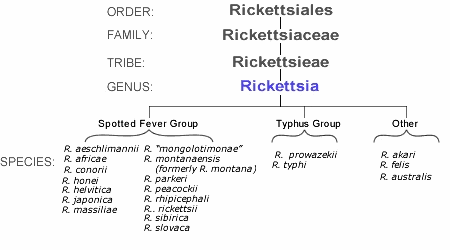
noun, plural rick·ett·si·ae [ri-ket-see-ee] /rɪˈkɛt siˌi/, rick·ett·si·as [ri-ket-see-uh z] /rɪˈkɛt si əz/.
- any member of the genus Rickettsia, comprising rod-shaped to coccoid microorganisms that resemble bacteria but can be as small as a large virus and reproduce only inside a living cell, parasitic in fleas, ticks, lice, and mites and transmitted by bite to vertebrate hosts, including humans, causing such severe diseases as typhus and Rocky Mountain spotted fever.
- any rickettsia or rickettsialike microorganism of the orders Rickettsiales and Chlamydiales.
noun plural -siae (-sɪˌiː) or -sias
- any of a group of parasitic bacteria that live in the tissues of ticks, mites, and other arthropods, and cause disease when transmitted to man and other animals
parasitic organism, 1919, named 1916 in Modern Latin by H. da Rocha-Lima in honor of U.S. pathologist H.T. Ricketts (1871-1910), who first identified it in 1909 and died of typhus as a result of his contact with it. The bacteria causes typhus and Rocky Mountain spotted fever, but is unrelated by pathology or etymology to rickets (q.v.), which is the result of vitamin D deficiency. The surname is a development from Rickard, variant of Richard, or else from the diminutive form Ricot.
adj.
- Relating to, or caused by a member of the genus Rickettsia.
n.
- A genus of gram-negative bacteria that are carried as parasites by many ticks, fleas, and lice and cause diseases such as typhus, scrub typhus, and Rocky Mountain spotted fever.
 Liberal Dictionary English Dictionary
Liberal Dictionary English Dictionary